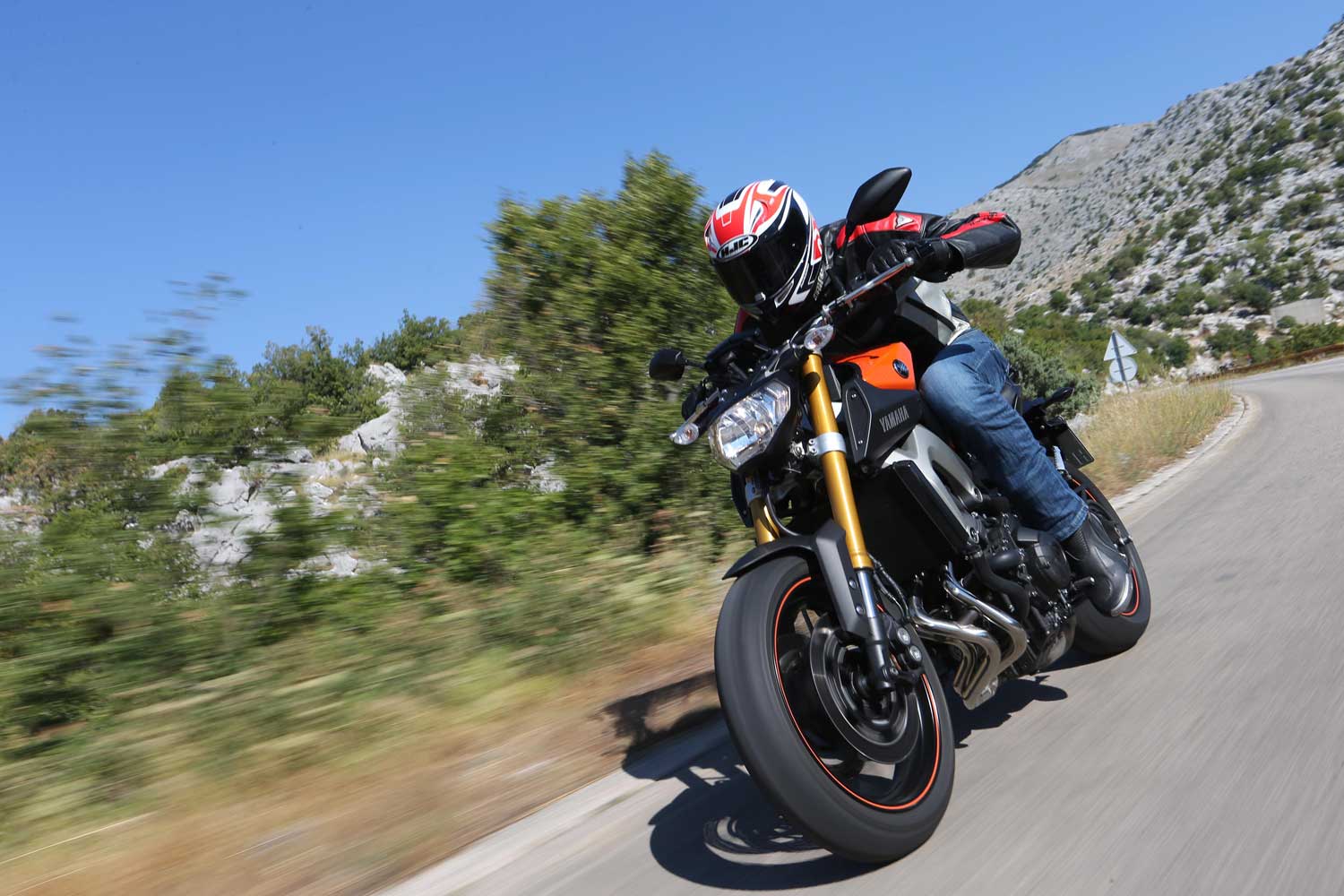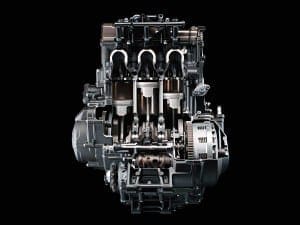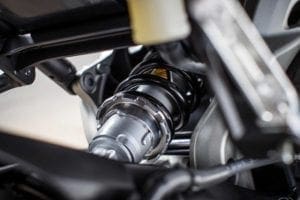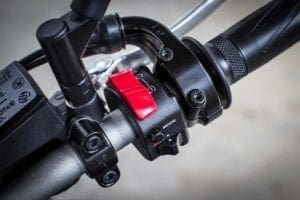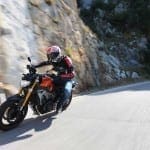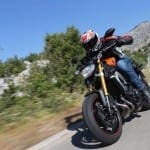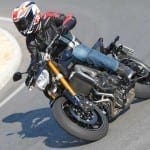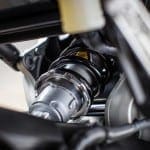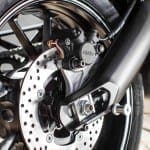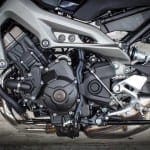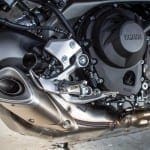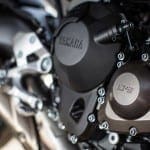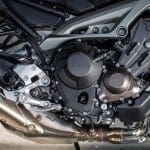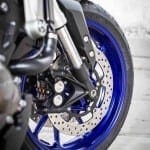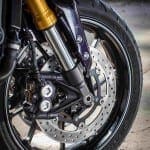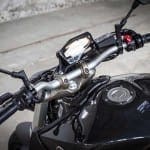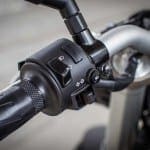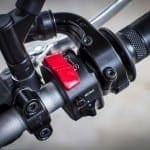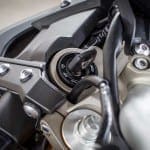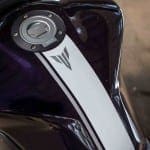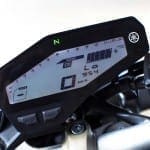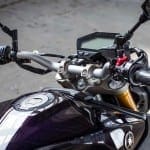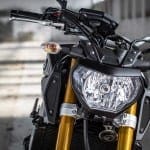£6949 | 113bhp@10,000rpm | 64.5lb-ft@8000rpm | 847cc liquid-cooled triple
Tested by Roland Brown. Motorcycle Journalist and former international racer, Roland Brown is one of the world’s most respected bike testers. Subscribe to his fantastic YouTube channel – iMotorcycle Video – here.
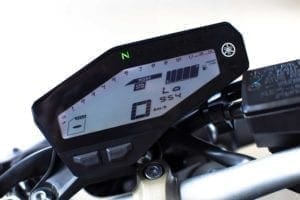 Given the way Yamaha suffered in the credit crunch, with high prices and falling sales, the MT-09 is surely one of the most significant bikes the firm has ever produced. This 847cc naked triple is leading the Japanese giant’s attempt to regain a reputation for exciting and competitively priced bikes, and it’s just what the firm needed.
Given the way Yamaha suffered in the credit crunch, with high prices and falling sales, the MT-09 is surely one of the most significant bikes the firm has ever produced. This 847cc naked triple is leading the Japanese giant’s attempt to regain a reputation for exciting and competitively priced bikes, and it’s just what the firm needed.
A naked middleweight triple like the MT was an ideal type of bike to lead the comeback, following the example of successful European models such as Triumph’s Street Triple and MV Agusta’s smaller Brutales. Those bikes prove that squeezing a compact three-cylinder engine into a stiff, aluminium-framed chassis can create a torquey, light and entertaining machine. Yamaha’s challenger follows the same format with spectacular results.
The liquid-cooled, dohc 12-valve triple is designed for midrange torque as much as for horsepower. Its peak output of 113bhp is high for such a light bike, and the MT makes considerably more torque throughout the rev range than the FZ8’s four-cylinder unit, despite weighing 10kg less, at 60kg. The 120-degree crankshaft engine’s cylinders are inclined forwards at 42.5 degrees, and are offset by 5mm from the crank, which helps minimise friction by reducing sideways force on the pistons.
Throttle control is by a version of Yamaha’ YCC-T (Yamaha Chip Controlled Throttle), as on the R1 and R6. The intake trumpets are of different, though not variable, lengths, which Yamaha says “creates complimentary power and torque curves”. There’s no traction control. The three riding modes, selectable via a button on the right bar, vary the speed that the butterflies are opened but don’t use different fuel maps.
Yamaha made a big effort to make the MT-09 not only light but also inexpensive to produce. Its new cast aluminium twin-spar frame and swing-arm help give a claimed wet weight of 188kg, just 5kg up on the less powerful Street Triple’s figure and far lower than Japanese fours such as Kawasaki’s Z800, Suzuki’s GSR750 and Yamaha’s own FZ8.
The die-cast aluminium frame is made in left and right halves, which are bolted together at steering head and swing-arm pivot. The die-cast swing-arm is welded together with extruded cross-members for extra rigidity. The swing-arm pivot is on the outside of the frame, reducing width around the footrests and allowing a high static lean angle of 51 degrees. That claimed wet weight figure of 188kg is a kilo lower than that of Yamaha’s YZF-R6 super-sports four, which illustrates what a thorough job the MT’s designers did.
There are plenty of good reasons why you should consider the MT very seriously if you’re in the market for an exciting naked middleweight. Its performance is very competitive, its styling (in choice of four colours) and finish quality are excellent, and overall it’s the most impressive and promising new Yamaha for a long time. It looks like being the pick of the naked Japanese fours, making the likes of Suzuki’s GSR750 and Kawasaki’s Z800 seem overweight and off the pace.
And arguably the most impressive thing about the MT-09 is that Yamaha have managed to put it in showrooms at a very competitive price (initially £6799, though it was increased to £6949 in May). The MT’s throttle response and front suspension action aren’t quite perfect, suggesting that there’s a little more fine-tuning to be done. In an ideal world you’d perhaps wait for an updated model that is likely to have these teething issues sorted. But if you were set on buying an MT-09 right now, we wouldn’t try to change your mind.
So what’s it like to ride?
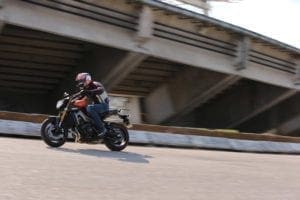 If you want one word: exciting. Or maybe thrilling, invigorating, involving or fun. It’s a simple, light and torquey naked motorbike that goes like stink and is also pretty rider friendly, though not without a couple of niggles. The view from its low, flat and quite narrow seat is of a small, angular digital display that’s offset slightly to the right, with the ignition lock on the left. The bars are raised and quite pulled back, giving an upright riding position that felt roomy in conjunction with reasonably rearset footrests.
If you want one word: exciting. Or maybe thrilling, invigorating, involving or fun. It’s a simple, light and torquey naked motorbike that goes like stink and is also pretty rider friendly, though not without a couple of niggles. The view from its low, flat and quite narrow seat is of a small, angular digital display that’s offset slightly to the right, with the ignition lock on the left. The bars are raised and quite pulled back, giving an upright riding position that felt roomy in conjunction with reasonably rearset footrests.
The motor is very flexible, happy to send the Yamaha surging forward from below 4000rpm, then pulling harder through the midrange and keeping going with a smooth rush of power towards the redline at 11,300rpm. There’s enough grunt to encourage short-shifting and using the higher ratios, but the six-speed box was so slick, and the Yamaha so addictively rev-happy, that it was generally even more fun to give my right wrist and left ankle more work by caning it through the gears. Shame there wasn’t more noise through the airbox and the exhaust’s mid-mounted silencer, which were disappointingly quiet even under hard acceleration.
For fast and furious road use the Yamaha was more than quick enough, at least in its two sportier riding modes. It ripped off the line with front wheel itching to rise, accelerated past traffic at a hell of a rate given a tweak of throttle in the higher gears, and sat at an indicated 80mph feeling utterly untroubled. On one short straight it leapt to an indicated 125mph, still with plenty left to a top speed of around 140mph.
 The only drawback is that throttle response isn’t always as smooth as it should be. There are three riding modes, selectable with a small button on the right bar. On start-up you’re in Standard, and have the option of sportier A or softer B, both of which keep the 113bhp max with differing throttle response from the ride-by-wire system. Trouble is, in either Standard or A the response is snatchy, snapping the bike forward almost as though there’s play in the transmission.
The only drawback is that throttle response isn’t always as smooth as it should be. There are three riding modes, selectable with a small button on the right bar. On start-up you’re in Standard, and have the option of sportier A or softer B, both of which keep the 113bhp max with differing throttle response from the ride-by-wire system. Trouble is, in either Standard or A the response is snatchy, snapping the bike forward almost as though there’s play in the transmission.
It’s not a major problem, but makes for a slightly jerky ride in town, and doesn’t aid control when winding on the power out of turns. Selecting B mode gives a notably smoother take-up (some riders left it in B almost all the time), at the expense of some of that storming acceleration.
The chassis follows the engine by being essentially sound, but not perfectly sorted. The basics are in place, notably that beefy yet light aluminium frame and swing-arm, plus sporty geometry that helps give the Yam a responsive, urgent feel. The MT steers with a slight nudge of those wide bars, too, yet stayed stable at speed in a straight line and through fast curves alike. But in slower turns it sometimes had a slightly nervous, twitchy feel.
For a moment I suspected the tyre, as some of the roads on the launch in Croatia were dusty and slippery, but it wasn’t a slide and the Bridgestone S20s generally did a good job. A more likely reason is just that the MT’s forks have a lot of travel — 137mm, compared to 110mm for the Street Triple — and the damping wasn’t up to keeping it perfectly under control. Backing off the preload and adding rebound damping seemed to help, but the rebound was already just one turn from its maximum setting.
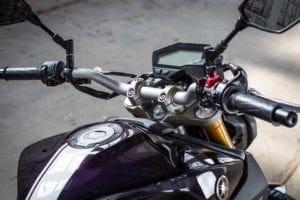 It’s a shame the MT’s set-up isn’t quite right because as tested it can’t match the agility that is one of the Street Triple’s greatest assets, and makes it so appealing for novice and experienced riders alike. At least the generous suspension travel helped give a wrist-friendly ride quality, and was backed up by a competent rear shock. The MT clattered slightly over bigger bumps but generally soaked up everything the roads threw at it.
It’s a shame the MT’s set-up isn’t quite right because as tested it can’t match the agility that is one of the Street Triple’s greatest assets, and makes it so appealing for novice and experienced riders alike. At least the generous suspension travel helped give a wrist-friendly ride quality, and was backed up by a competent rear shock. The MT clattered slightly over bigger bumps but generally soaked up everything the roads threw at it.
The Yam’s levels of comfort and practicality were pretty high, too. Its thinly padded seat was starting to feel slightly uncomfortable towards the end of a near 200-mile day, but its rear is wide enough to give fairly good support. Although the tank is small at 14 litres, the engine is good for almost 50mpg so gives a respectable realistic range of around 120 miles.
Most other chassis bits worked well, including the brakes, with the twin front discs and four-pot radial monobloc calipers having plenty of bite if not quite as much feel as some systems. The launch bikes were the non-ABS equipped models. I’d be tempted to choose the ABS model although it’s £400 more expensive, at £7349.
There are also plenty of accessories with which to bump up the price. You can add sporty parts such as flyscreen, billet levers or Akrapovic pipe; or improve practicality with a comfort seat, hard luggage or electrical socket. Kitted out with some of those parts, this naked hooligan will become a passably practical all-rounder.
But it’s for its fun factor that the MT-09 stands out — not just from other recent Yamahas but from its four-cylinder compatriots too. Those fuelling and suspension glitches mean the triple doesn’t quite live up to the promise of its outstanding power and weight statistics. But it’s still a superbly quick, agile and entertaining machine that proves Yamaha is back and capable of building a bike that is as competitively priced as it’s good to ride.
Tech Spec
Price: £6949 (ABS model £7349)
Engine: 847cc, liquid-cooled, dohc 12-valve triple
Power: 113bhp (84kW) @ 10,000rpm
Torque: 64.5lb-ft (87.5N.m) @ 8000rpm
Kerb weight: 188kg (191kg with ABS)
Seat height: 815mm
Tank size: 14 litres
Read the exclusive first ride of the new MT-09 Street Rally here.

